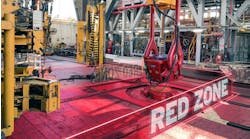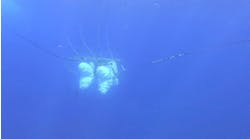Clump weights offer sound, economical mooring system option
Ralitsa Peycheva, FMGC
For some years clump weights have been integrated into the oil and gas mooring systems, but the technology has faced some issues and failures; which has led to the bad reputation of the technology. However, clump weights represent an innovative way to optimize the cost efficiency of offshore mooring systems, and they are being increasingly applied in various mooring designs.
If designed and manufactured by taking into account lessons learned from the past, clump weights offer a great opportunity for optimized offshore mooring systems. They can easily turn into a better solution, meeting the challenges of the floating structures and improving the performance of all involved devices at a reasonable cost.
One of the main considerations is the close work with the customer from the basic design to mass production, ensuring the knowledge about the configuration, which the mooring system will secure as design and size of the platform, site conditions, and water depth.
The clump weight solution restricts the movements of the floating structure by contributing to the restoring forces in relatively shallow waters, without resorting to expensive solutions or longer mooring lines length. Thus they offset a part of the vertical forces against the anchor in catenary or semi-taut design.
Clump weights can be applied on oil and gas installations, floating offshore wind turbines, wave energy converters (WEC), floating tidal stream devices, and offshore aquaculture installations. All these installations are subject to various environmental conditions. Therefore, the design and the material choice of the clump weights should successfully cover the requirements of various mooring systems.
FMGC has developed two clump weight configurations, adaptable to the specificity of every mooring system. The company is able to dimension and customize these clump weights and the associated validation steps according to the specific project requirements on both distributed and mutualized configurations.
The “distributed” configuration represents a set of medium-sized clump weights, distributed over a segment of ground chains near the touchdown point to increase the restoring forces. This configuration optimizes the effectiveness and the cost of the solution thanks to the proportional recovery of the loads and the most accurate dimensioning.
The “mutualized” solution consists of one clump weight, attached to one specific point of the upper part of the mooring lines. This configuration neutralizes some of the impact of wind and wave and thus limits the tensions on the anchoring line.
The engineering design objectives of these types of clump weights can be summarized as follows:
• Ensuring restoring forces by providing a larger reaction to the floating platform displacements
• Limiting excessive line tensions in order to avoid breakages
• Limiting vertical loads on the anchors when clump weights are positioned at the touchdown point
• Providing a reduction of the mooring line length by adding additional masses in specific zones of the mooring system.
The efficiency and reliability of clump weights for offshore mooring systems depend on the considerations described below.
Collaboration with customer. The collaboration with the customer from the basic design to the mass production is a milestone when trying to provide the best possible efficiency and reliability. A good solution should be fully tailorable in accordance with the mooring design specifications and the requirements of the customers. The weight, the shapes, the chain link footprint, the lifting and fastening systems for example can be designed and adapted accordingly.
Since clump weights have different purposes and locations on the mooring lines and are subject to various environmental conditions, the knowledge about the future project is of essential importance.
For example, clump weights in a catenary mooring system should provide restoring forces to the excursion movement or limit the vertical loads on the anchors. In this case a clump weight system based on several units spread along a section of the mooring line near the touchdown point is the most suitable solution.
On the other hand, in a mooring system with higher tension (semi-taut for example) and if the purpose is to limit excessive line tension and provide a reaction to the floating platform displacements, a system with heavier clump weights, positioned closer to the floating platform, seems to be more efficient.
Numerical analysis and tests. It is of a huge importance if the manufacturer can achieve numerical analysis and tests on prototypes ensuring the reliability of the clump weights, taking in consideration the possible interactions with other mooring components.
Material choice. The material, which the clump weights are made of, is of critical importance as well for the efficiency and reliability of the installation. Cast iron offers the best choice providing density, resistance, and superior technical characteristics. It features an optimal balance between mechanical properties and cost efficiency.
The compacity, density, and efficiency of cast iron are far better compared to most of the other possible material for offshore purposes. In the distributed configuration the high density of the cast iron allows to provide the weight needed to ensure the restoring forces in a really compact volume, allowing not only to avoid the additional hydrodynamics loads, but also to ease the implementation on the mooring system. This eases the installation, but also limits the footprint of the clump weights once deployed.
In the mutualized configuration the density ensures a more compact solution, which is less subject to hydrodynamic loads, allowing both a reduction of the needed weight but also a better stability of the hanging clump weights.
Site installation specifications. In order to ensure optimal efficiency and reliability of the mooring system, its various components need to be designed in accordance with the specifications of the project and the site. Their proper dimensioning, design life and the loads to withstand depend on the bathymetrie and the metocean data but as well on the design of the platform.
Clump weights are a highly efficient stabilization component and thus one of the solutions when it comes to a mooring system improvement. An offshore installation is kept in place by a sophisticated mooring system, taking all permanent, variable and environmental loads. To be as robust, the system should be properly designed, manufactured, installed, and maintained.
The exact position of the clump weights on the mooring system and their contribution to the mooring efficiency make them a critical component. The design and the material which the clump weights are made of are the key elements, ensuring the needed performance and the high quality. •



